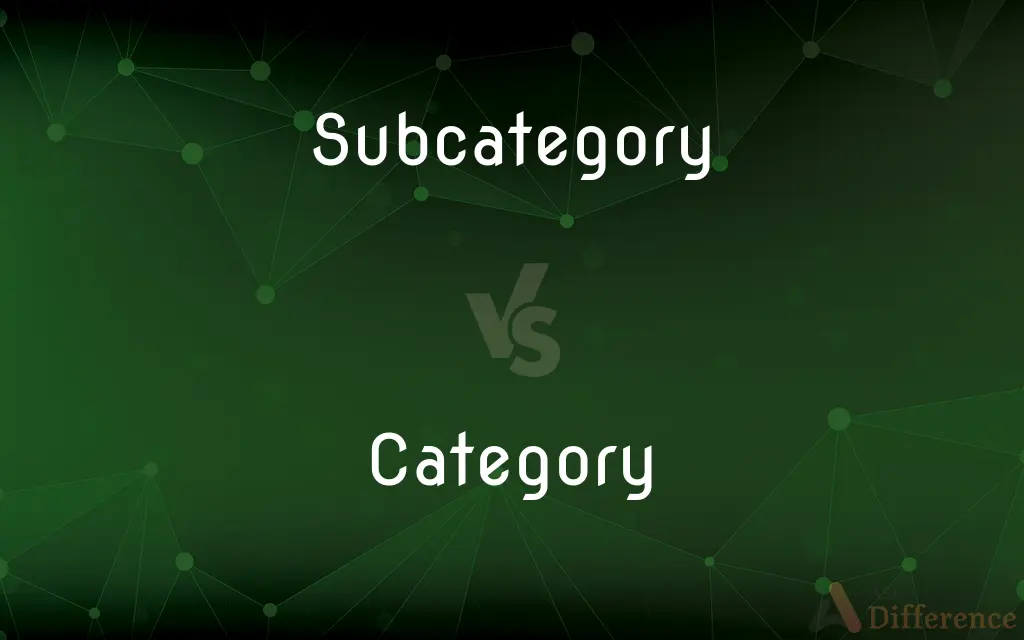Subcategory vs. Category — What's the Difference?
By Fiza Rafique & Urooj Arif — Updated on May 2, 2024
A category is a broad classification or grouping, whereas a subcategory is a more specific division within a category.

Difference Between Subcategory and Category
Table of Contents
ADVERTISEMENT
Key Differences
A category represents a wide-ranging group used to organize concepts, items, or data based on shared characteristics. For example, in retail, "Electronics" is a common category. On the other hand, a subcategory is a narrower classification that falls under a broader category, providing more detailed grouping. For instance, under the "Electronics" category, "Smartphones" is a subcategory.
Categories serve as the primary means of structuring and simplifying complex sets of items or data, making them more accessible and understandable. Whereas subcategories further refine this structure by dividing categories into more specific segments, enhancing the granularity of the classification.
In taxonomy, a category defines a rank or level in a hierarchical system used to classify organisms, such as "Genus". Meanwhile, subcategories do not typically apply in this scientific context, as taxonomy strictly adheres to predefined ranks without intermediate levels.
In information systems, categories are used to broadly organize data, which aids in efficient navigation and retrieval. Subcategories, on the other hand, allow for more precise filtering and sorting of information within those broad parameters.
While categories provide a general overview or grouping, subcategories are crucial for addressing the nuances and diversity within any large category, allowing for more targeted discussions, analyses, or marketing strategies.
ADVERTISEMENT
Comparison Chart
Scope
Narrow
Broad
Function
Detailed segmentation
Organizational base
Examples
Smartphones, Novels, Electric cars
Electronics, Literature, Vehicles
Usage in taxonomy
Not applicable
Specific ranks (e.g., Genus)
Importance
Enhances specificity within categories
Simplifies complex sets
Compare with Definitions
Subcategory
A more specific group within a category.
Under the category of beverages, coffee is a subcategory.
Category
A designation for award or competition classes.
The film was nominated in the best foreign-language category.
Subcategory
A secondary classification within a main grouping.
In the bookstore, mystery is a subcategory under fiction.
Category
A class or division of people or things regarded as having particular shared characteristics.
Category includes broad terms like animals, vehicles, and furniture.
Subcategory
A narrower division for detailed organization.
The subcategory of electric guitars can be found under musical instruments.
Category
A grouping based on similar characteristics.
Food and drink is a popular category on a menu.
Subcategory
A specific subgroup used in sorting or organizing.
Each main category was divided into several subcategories for easier access.
Category
A division in a system of classification.
Different categories of membership are available depending on the benefits.
Subcategory
A further breakdown of a category for precise classification.
Subcategories of heart disease include arrhythmia and cardiomyopathy.
Category
A classification in a system of taxonomy.
Species is a category in the biological classification.
Subcategory
In mathematics, specifically category theory, a subcategory of a category C is a category S whose objects are objects in C and whose morphisms are morphisms in C with the same identities and composition of morphisms. Intuitively, a subcategory of C is a category obtained from C by "removing" some of its objects and arrows.
Category
A class or division of people or things regarded as having particular shared characteristics
The various categories of research
Subcategory
A subdivision that has common differentiating characteristics within a larger category.
Category
Each of a possibly exhaustive set of classes among which all things might be distributed.
Subcategory
With respect to a given category, a more narrow category.
Category
A specifically defined division in a system of classification; a class.
Subcategory
(category theory) A subclass of a category which is itself a category, whose arrows are a restriction of the arrows of the parent category, and whose composition rule is a restriction of the parent category's
Category
Aristotle's modes of objective being, such as quality, quantity, or relation, that are inherent in all things.
Category
Kant's modes of subjective understanding, such as singularity, universality, or particularity, that organize perceptions into knowledge.
Category
A basic logical type of philosophical conception in post-Kantian philosophy.
Category
A property or structural unit of a language, such as a part of speech or a type of phrase.
Category
A specific grammatical defining property of a linguistic unit or class, such as number or gender in the noun and tense or voice in the verb.
Category
(Mathematics) A class of objects, together with a class of morphisms between those objects, and an associative composition rule for those morphisms. Categories are used to study a wide variety of mathematical constructions in a similar way.
Category
A group, often named or numbered, to which items are assigned based on similarity or defined criteria.
This steep and dangerous climb belongs to the most difficult category.
I wouldn't put this book in the same category as the author's first novel.
Category
(mathematics) A collection of objects, together with a transitively closed collection of composable arrows between them, such that every object has an identity arrow, and such that arrow composition is associative.
One well-known category has sets as objects and functions as arrows.
Just as a monoid consists of an underlying set with a binary operation "on top of it" which is closed, associative and with an identity, a category consists of an underlying digraph with an arrow composition operation "on top of it" which is transitively closed, associative, and with an identity at each object. In fact, a category's composition operation, when restricted to a single one of its objects, turns that object's set of arrows (which would all be loops) into a monoid.
Category
One of the highest classes to which the objects of knowledge or thought can be reduced, and by which they can be arranged in a system; an ultimate or undecomposable conception; a predicament.
The categories or predicaments - the former a Greek word, the latter its literal translation in the Latin language - were intended by Aristotle and his followers as an enumeration of all things capable of being named; an enumeration by the summa genera i.e., the most extensive classes into which things could be distributed.
Category
Class; also, state, condition, or predicament; as, we are both in the same category.
There is in modern literature a whole class of writers standing within the same category.
Category
A collection of things sharing a common attribute;
There are two classes of detergents
Category
A general concept that marks divisions or coordinations in a conceptual scheme
Common Curiosities
What is a subcategory?
A subcategory is a more specific division within a broader category, used to organize related subsets further.
How does a subcategory differ from a category?
A subcategory is narrower and more specific, focusing on a subset within a general category.
Can a subcategory have its own subcategories?
Yes, a subcategory can be divided into further subcategories to provide even more detailed classifications.
Are categories and subcategories used in digital databases?
Yes, they are essential for structuring data in databases, improving searchability and retrieval.
What is a category?
A category is a broad classification that groups items, concepts, or information based on shared characteristics.
Why are categories and subcategories important?
They help in organizing complex information into manageable and understandable segments.
How do categories aid in decision-making?
Categories simplify choices by grouping similar options, thereby aiding quicker and more effective decision-making.
How do categories simplify learning and understanding?
By organizing knowledge into broad areas, categories help in easier assimilation and recall of information.
What role do categories play in data analysis?
Categories help in segmenting data for better analysis, interpretation, and visualization.
How do subcategories enhance online shopping experiences?
Subcategories allow customers to filter products more precisely, leading to easier and more targeted shopping experiences.
What is the impact of accurate categorization in business?
Accurate categorization enhances inventory management, marketing strategies, and customer satisfaction.
Share Your Discovery

Previous Comparison
Subliminal vs. Liminal
Next Comparison
Jumper vs. HoodieAuthor Spotlight
Written by
Fiza RafiqueFiza Rafique is a skilled content writer at AskDifference.com, where she meticulously refines and enhances written pieces. Drawing from her vast editorial expertise, Fiza ensures clarity, accuracy, and precision in every article. Passionate about language, she continually seeks to elevate the quality of content for readers worldwide.
Co-written by
Urooj ArifUrooj is a skilled content writer at Ask Difference, known for her exceptional ability to simplify complex topics into engaging and informative content. With a passion for research and a flair for clear, concise writing, she consistently delivers articles that resonate with our diverse audience.
















































